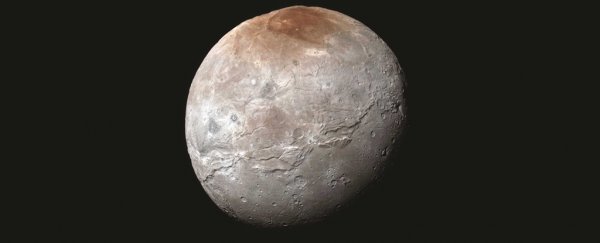Pluto's life partner, Charon, has a disarming red 'cap'. Ever since New Horizons snapped the moon's rust-tinted north pole on its 2015 flyby, scientists have pondered the planetary processes responsible for leaving such a bold landmark.
Scientists initially suspected the iron-colored smear (nicknamed Mordor Macula) was methane captured from Pluto's surface, its red color the result of a slow baking in the Sun's ultraviolet light. It was a neat idea just begging to be tested.
Now a mix of modeling and laboratory experiments has found these early assumptions weren't too far from the mark, with a slight twist. The research adds surprising new details to our understanding of Pluto's and Charon's intimate engagement, suggesting there's more to the moon's coloring than first meets the eye.
Launched back in 2006, NASA's interplanetary space probe New Horizons provided researchers with an unprecedented view of the dwarf planetary system Pluto and Charon at a distance of more than 5 billion kilometers (3.1 billion miles) from the Sun.
"Prior to New Horizons, the best Hubble images of Pluto revealed only a fuzzy blob of reflected light," says Randy Gladstone, a planetary scientist from the Southwest Research Institute (SwRI) in the US.
"In addition to all the fascinating features discovered on Pluto's surface, the flyby revealed an unusual feature on Charon; a surprising red cap centered on its north pole."
Red might not be an unusual color to see on iron-rich worlds like ours, or Mars for that matter. But all the way out in the Solar System's frozen suburbs, red is far more likely to indicate the presence of a diverse group of tar-like compounds called tholins.
If it helps, just replace the word tholin with 'gunk'. The brownish-red mess of chemicals is like the residue left in the oven, if the oven used UV light to bake brownies made of simple gases like carbon dioxide or ammonia.
On Pluto, methane would be a likely starting place. To grow into a tholin, these tiny hydrocarbons would simply need to absorb a very specific color of UV light filtered by orbiting hydrogen clouds, called Lyman-alpha.
Pluto's rosy glow has been the subject of study for decades. New Horizons simply revealed the precise patterning of tholins on its surface in glorious high definition. Finding a rusty tint cast across the cap of its companion, however, was an intriguing surprise.
It was presumed methane shed from Pluto could drift across to its orbiting moon. But the precise timing needed for the gas to settle and freeze into such a distinctively diffuse smear was always a sticking point.
Part of the problem is the contest between Charon's weak gravity and the cold light of the far-off Sun that warmed its surface. As faint as it was, the spring dawn could be sufficient to melt the methane frost, driving it from the surface again.
To determine what would really happen, SwRI researchers modeled the see-sawing motion of the largely tilted planet system. The secret to the smear, they found, might be the explosive nature of spring's arrival.
The relatively sudden warming of the north pole would take place over several years – a mere blink in the moon's 248-year orbit of the Sun. During this brief period, a pall of methane frost just tens of microns thick would evaporate at one pole as it began to freeze over at the other.
Unfortunately, the modeling found this rapid movement would be far too quick for much of the frozen methane to absorb sufficient amounts of Lyman-alpha to become a tholin.
But ethane – methane's slightly longer hydrocarbon cousin – would be a whole other story.
"Ethane is less volatile than methane and stays frozen to Charon's surface long after spring sunrise," says planetary scientist Ujjwal Raut, lead author of a second study that modeled changes in the densities of methane evaporating and freezing.
"Exposure to the solar wind may convert ethane into persistent reddish surface deposits contributing to Charon's red cap."
Together with the results of laboratory experiments, Raut and his team's study demonstrated a feasible way methane could be turned into ethane at the poles.
There was just one problem. Lyman-alpha radiation won't turn ethane into a reddish sludge.
That doesn't rule the hydrocarbon out. Charged particles streaming from the Sun over a longer period could still generate increasingly longer chains of hydrocarbons that would give Charon its characteristic red cap.
"We think ionizing radiation from the solar wind decomposes the Lyman-alpha-cooked polar frost to synthesize increasingly complex, redder materials responsible for the unique albedo on this enigmatic moon," says Raut.
Further laboratory testing and modelling could help solidify the hypothesis that Charon's rouge stain is far more complex than we ever realized.
This research was published in Science and Geophysical Research Letters.
